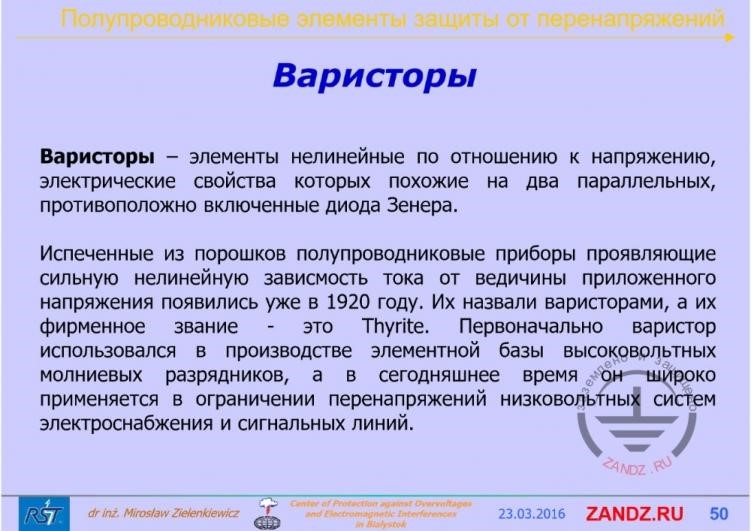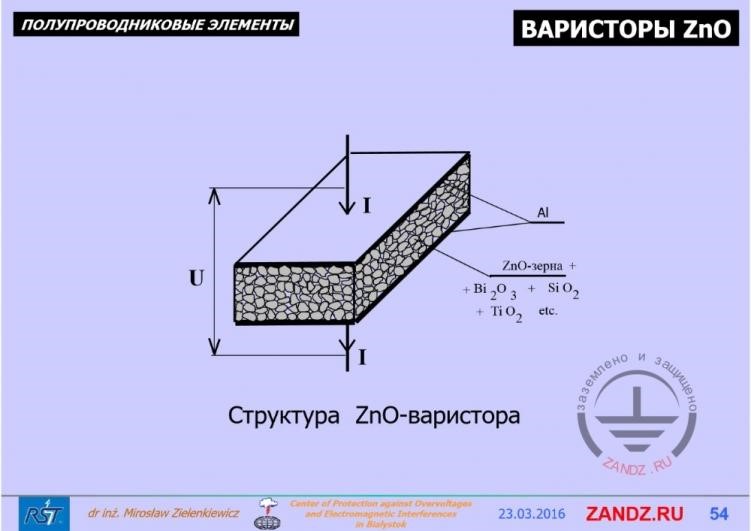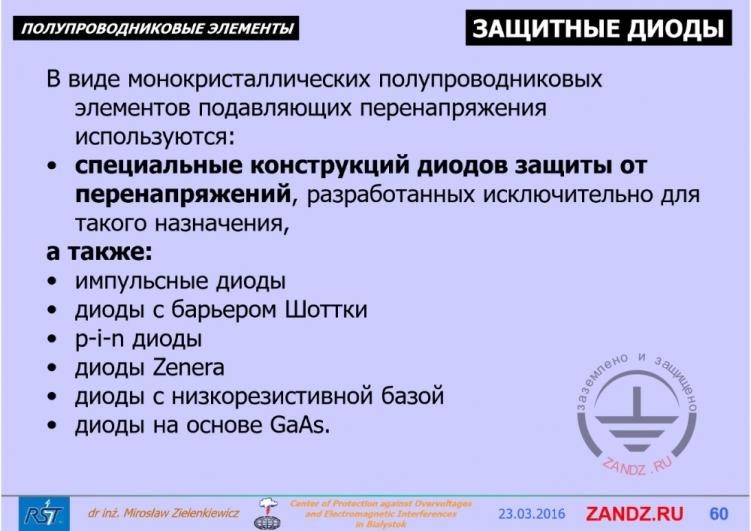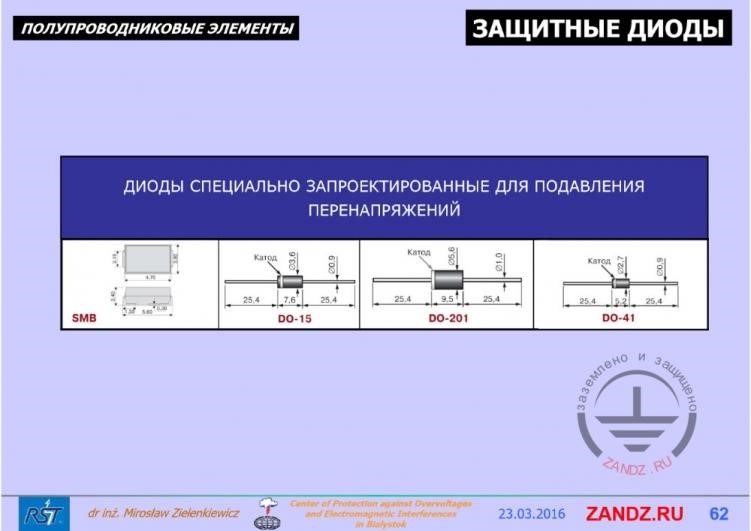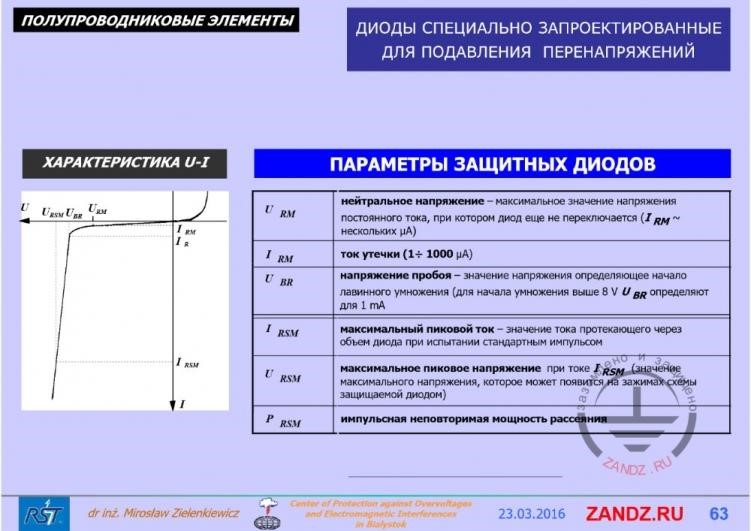The second webinar from the series "Surge protection"
Webinar text. Page 4
Quick navigation through slides:
<< Page 1:
1. Surge protection for power lines 230/400 V 50 Hz Part 1
2. About Miroslav Zelenkevich
3. Main circuit of enabling surge protection elements
4. Cascade protection circuit
5. SPD – the main protection circuit
6. Gas-discharge and semi-conductor devices
7. Spark air gap
8. Forms of gas-filled electrodes
9. Picture of two electrodes
10. Picture of railway line
11. Spark arresters of old type
12. Coal arresters
13. Why coal
14. customer line connection circuit
15. Coal arresters’ operation principle
<< Page 2:
16. Protection of pole-mounted transformer substation
17. Gas arresters of 6 kV line
18. Construction of gas arresters
19. Additional protection element
20. Characteristics of protection element
21. Advantages of gas discharge elements
22. Gas filled arresters
23. Railway arresters
24. Construction of gas filled arresters
25. Gas filled arresters of minor energy
26. Cross section of an arrester
27. Arrester in direct current circuit
28. Arrester in alternate current circuit
29. Sine-wave voltage impact on an arrester
30. Arrester - pulse dialling
<< Page 3:
31. Residual pulse, missed by the arrester
32. Maximal voltage value
33. Discharge action steps at the protection of a device
34. The main parameters of arresters Part 1
35. The main parameters of arresters Part 2
36. The main parameters of arresters Part 3
37. Advantages of gas-filled arresters in low-frequency circuits
38. Example of electrical parameters of a 3- electrode arrester
39. Disadvantages of arresters in low-frequency circuits
40. Lightning current arresters
41. Arresters with arc division
42. Approximate parameters of arresters
43. Main application conditions for surge protection purposes
44. Dynamic pick-up voltage
45. HF and SHF elements
Page 4:
46. Semi-conductor surge protection elements
47. Variable resistors
48. Characteristics of U-I variable resistor
49. Structure of ZnO – variable resistor
50. Sizes of ZnO – variable resistor
51. Mono-crystal lattice
52. Three areas of volt-ampere characteristics
53. Advantages and disadvantages of ZnO variable resistors
54. Parameters of variable resistors Part 1
55. Parameters of variable resistors. Part 2
56. How to choose a variable resistor correctly?
57. Protective diodes.Types
58. Protective diode on an example of TRANSIL device structure
59. Designed diodes
60. Response characteristics
Page 5:>>
61. Types of protective diodes by the execution method
62. Advantages of protective diodes
63. Disadvantages of protective diodes
64. Protective diode operation stages
65. Protected device surge resistivity
66. Detector input circuit protection
67. Line repeater of phone line communication protection
68. All-round choice
69. Special purposes in surge protection of circuits
70. Low-voltage electricity supply surge protection
71. Arrester’s connection circuit in a construction project
72. Steppable cascade
73. Electricity supply network surge protection
74. Dynamic pickup voltage
75. Questions and answers
![]()
Overvoltage semiconductor surge protection elements
Поликристаллические полупроводники (варисторы) – polycrystal semi-conductors (variable resistors)
Монокристаллические полупроводники (диоды, тиристоры) – monocrystal semi-conductors (diodes, thyristors)
- Let's switch to the following elements now, which historically appeared after arresters - these are semiconductor surge protection elements. And here, like I already mentioned - it is polycrystal semiconductors (variable resistors) and monocrystal semiconductors (diodes and thyristors).
Полупроводниковые элементы защиты от перенапряжений - Overvoltage semiconductor surge protection elements
Variable resistors – non-linear elements in relation to overvoltage, electric properties of which are similar to two parallel, oppositely connected Zener’s diodes.
Being baked of powders, semi-conductor devices showing strong non-linear dependence of current on the value of the applied voltage, appeared in 1920. They were called variable resistors and their company name is Thyrite. Initially, a variable resistor was used in the production of the element base of high-voltage lightning dischargers, and today it is widely used in the surge protection of low-voltage power supply systems and signal lines.
- Polycrystal - this name is given because a variable resistor is a semi-conductor consisting of baked grains of certain material. If we look at the response circuit of such an element, we can agree that this is a simply nonlinear element in relation to voltage, the properties of which are similar to two parallel and opposite diodes of Zener. Such devices baked of powder showed strong nonlinear dependence of current on the value of the applied voltage and they appeared in the United States in 1920 and were called Thyrite. Initially such a variable resistor was used in the production of element base of high-voltage lightning arrestors, because the problems in the power supply circuit appeared there at once. And today such an element is widely used in the restriction of overvoltages of low-voltage power supply systems and signal lines, and such an element has its certain shortcomings, about which we should remember when we use it.
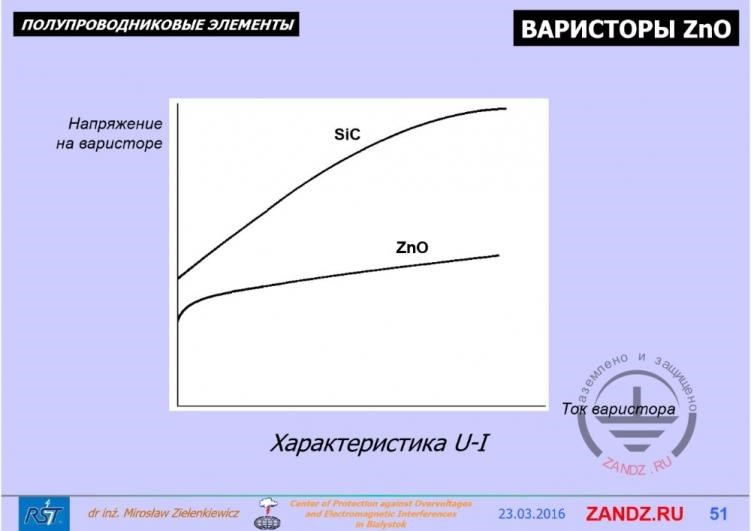
U-I variable resistor characteristics
Полупроводниковые элементы – semiconductor elements
Варисторы ZnO – ZnO variable resistors
Напряжение на варисторе – voltage on the variable resistor
Характеристика U-I – U-I characteristic
Ток варистора – Variable resistor current
- In reality, there appeared two materials in the technical equipment which I indicate in this picture for variable resistors. So initially it was a silicon carbide, we today meet it in high-voltage power supply lines and zinc oxide, which came 20-25 years ago and is now widely used. We see in this variable resistor characteristic, that for zinc oxide this characteristic is more useful for us, it has greater steepness and that is why this material is mainly used now.
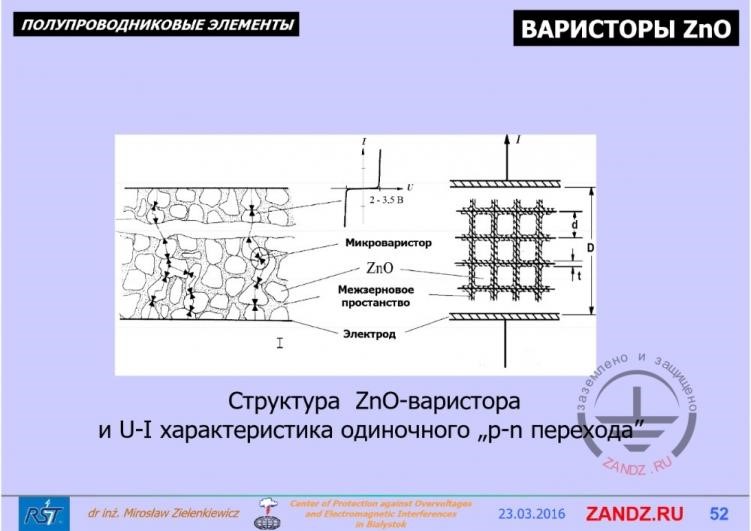
ZnO structure of a variable resistor
Полупроводниковые элементы – semiconductor elements
Варисторы ZnO – ZnO variable resistors
Структура ZnO варистора – Structure of ZnO variable resistor
И U-I характеристика одиночного p-n перехода – and U-I characteristic of a single p-n transit
-If we look at the structure of such a variable resistor, we will see that it consists of grans of zinc oxide. They are separated by a special powder, consisting of different kind of oxides and different metals, this is the secret of the manufacturer. In practice we get such diodes in the form of stars.
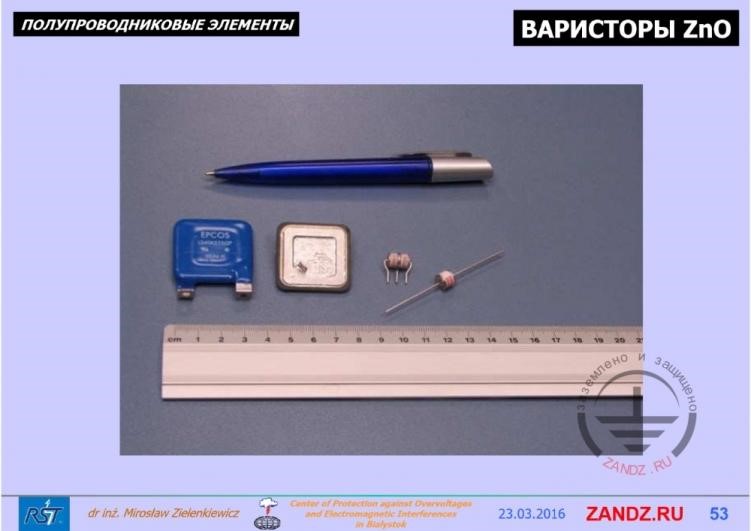
ZnO sizes of the variable resistor
Полупроводниковые элементы – semiconductor elements
Варисторы ZnO – ZnO variable resistors
- Since it is a baked powder, it has its certain problems. See, this element is much bigger than the miniature arrester and in practice, we study and buy such elements, we can easily define if this element has the sizes indicated here, it means it won't drain 20 kA current, 8/20 ms about which good manufacturers talk.
Полупроводниковые элементы – semiconductor elements
Варисторы ZnO – ZnO variable resistors
Структура ZnO варистора - ZnO variable resistors structure
- That is the structure of such an element, where to find semiconductor monocrystal ceramics. Two special electrodes are put and the great square of such an electrode allows to reduce this current square to the value for this element to function and not to fail. If we install it correctly and in the certain environment, where the rated currents are not exceeded.
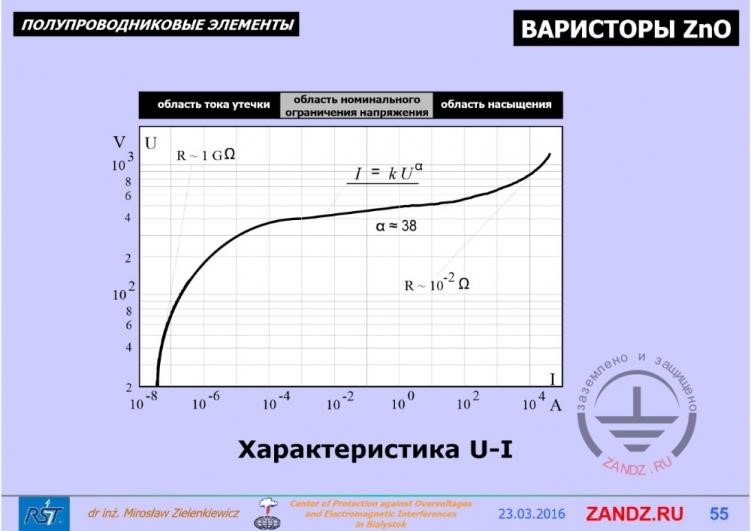
Three areas of volt-ampere characteristics
Полупроводниковые элементы – semiconductor elements
Варисторы ZnO – ZnO variable resistors
Область тока утечки – current leakage area
Область номинального ограничения напряжения- nominal voltage limit area
Область насыщения – saturation area
Характеристика U-I – U-I characteristics
- If we look at volt-ampere characteristics, we see that it possesses very strong nonlinearity and we differentiate three areas here. The area of current leakage, where there are small currents. If we look it is less than a mill ampere. The about one mill ampere, where rated voltage is characteristic, it is indicated in the catalogues. Response parameter in elements. We see such a band which is in the working mode up to several hundreds of amperes. The area of rated voltage limiting for this variable resistor. And then the area of saturation for this case in which the current starts to increase rated parameters which may bring to the burning of the element. If we look at the insulation resistance in this area of current leakage. In this area where the element waits for greater voltage. It is about 1 G Ohm and when we come to highly-conductive state; it is about 0, 01 Ohm. The resistance changes by times. And it means that in such values the great energy will be accumulated in our variable resistor and it may simply burn.
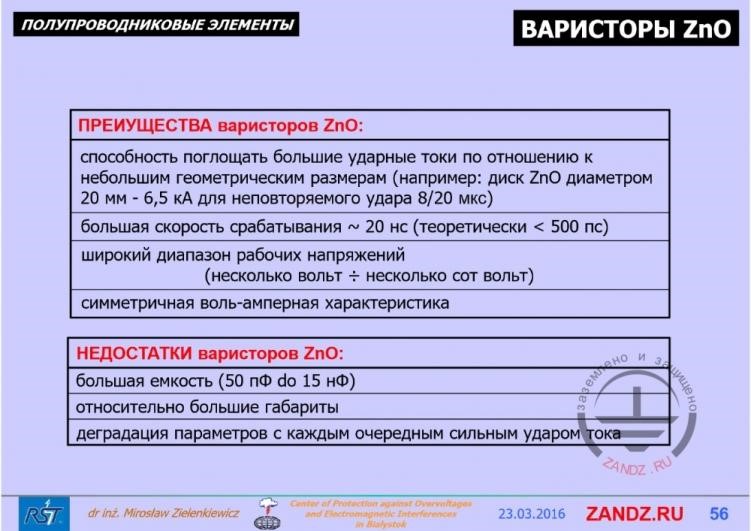
Advantages and disadvantages of ZnO variable resistors
Полупроводниковые элементы – semiconductor elements
Варисторы ZnO – ZnO variable resistors
Advantages of ZnO variable resistors:
Ability to absorb great surge currents in relation to some geometric sizes (for example: ZnO disk 20 mm in diameter- 6,5 kA for a non-repeated surge 8/20 ms)
Great response speed ~ 20 ns (in theory < 500 ps)
Wide range of working voltages (several volts: several hundreds on volts)
Symmetrical volt-ampere characteristics
Disadvantages of ZnO variable resistors:
Large capacity (50 pF to 15 nF)
Relatively large dimensions
Downgrading of parameters with each strong current rush
- Advantages of variable resistors is the ability to absorb great surge currents in relation to small geometric sizes. High response rate, the manufacturer indicates about 200 ns. I measured this parameter during the thesis, I did not see such time, it was shorter, much shorter. And here I simply indicated time, which I characterized at that period. It was less than 0,5 ns. These elements are characterized by a wide range of working voltage. It is characterized, as I said by thickness, and it is possible to meet elements which have response voltage from several volts to several hundreds of volts, but in reality the elements lower than 60-100 V are not stable. You should remember about it, if we look at the variable resistors of zinc oxide. Symmetrical volt-ampere characteristics is very important, it gives us positive result, since we apply one element on two-polarity of overvoltage pulses.
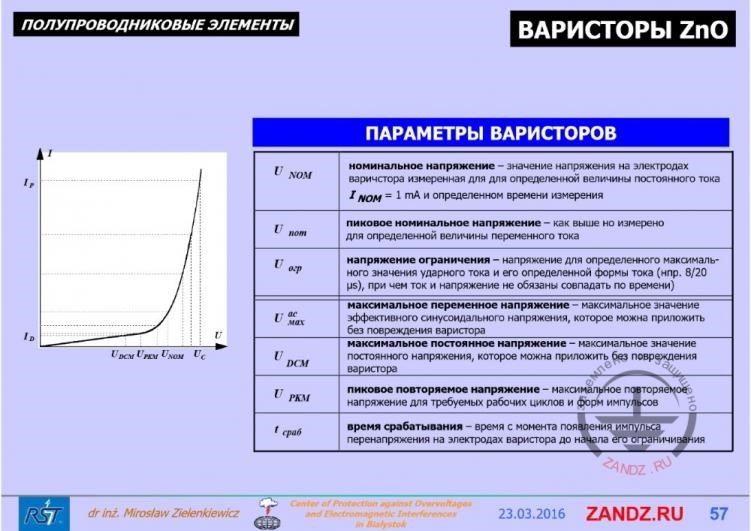
Parameters of variable resistors. Part 1
Полупроводниковые элементы – semiconductor elements
Варисторы ZnO – ZnO variable resistors
Parameters of variable resistors:
- nominal voltage – value of voltage on the variable resistor electrodes measured for a certain value of DC and a certain time of measuring
Peak nominal voltage – as above but measured to a certain value of AC
Clamping voltage – voltage for a certain maximal value of the surge current and its certain form of current (for example 8/20) at the current and the voltage are not obliged to coincide in time
Maximal alternating voltage – maximal value of effective sine-wave voltage which can be applied without a damage to the variable resistor
Maximal DC voltage – maximal value of DC voltage which can be applied without a damage to the variable resistor
Peak repeated voltage – maximal repeated voltage for the required working cycles and forms of pulses
Response time – time from the moment of appearing of overvoltage pulse on the variable resistor electrodes before its limiting
- There will be many parameters, I won't stop on them, but the designer should study them.
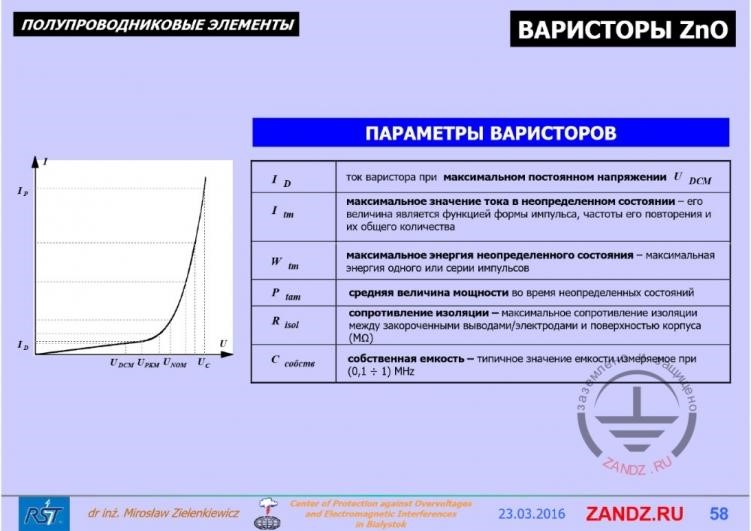
Parameters of variable resistors. Part 2
Полупроводниковые элементы – semiconductor elements
Варисторы ZnO – ZnO variable resistors
Parameters of variable resistors:
- variable resistor current at the maximal DC voltage
- maximal current value in an uncertain state – its value is the function of the pulse form, frequency of its repetition and their general quantity
- maximal energy of undetermined state – maximal energy of one or a series of pulses
-Average power value during undetermined states
Insulation resistance – maximal insulation resistance between the short-circuited inputs/electrodes and body surface
Own capacity – typical value of capacity measured at (o,1 : 1) MHz
- Please get familiarized with them, because I think that you might get a good hint what element to choose for working with.
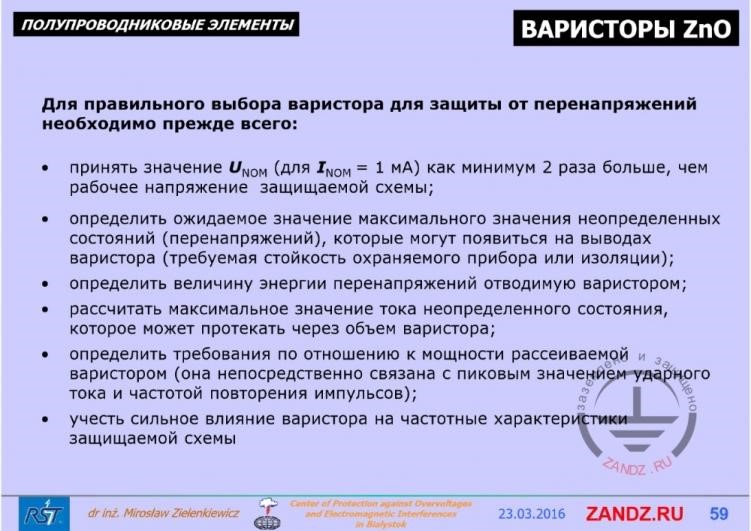
How to choose the variable resistor correctly?
Полупроводниковые элементы – semiconductor elements
Варисторы ZnO – ZnO variable resistors
For a correct choice of a variable resistor for surge protection the following should be done:
- accept the value Unom (as Inom = 1 mA) at least twice higher, than the working voltage of the protected circuit
- define the expected value of the maximal value of undetermined states (overvoltages), which may appear at the outputs of the variable resistor (required resistivity of the protected device and insulation)
- determine the value of overvoltages energy drained by the variable resistor
- calculate the maximal value of the undetermined state current which may flow though the volume of the variable resistor
- define requirements in relation to the power dispersed by the variable resistor (it is directly connected with the peak value of the surge current and frequency of pulses repetition)
- consider the strong influence of the variable resistor to frequency characteristics of the protected citcuit
- In practice, when we choose a variable resistor, it is good to be guided by the items indicated here, when we use surge protection. And if we, for example, knowing the rated voltage which is determined for a rated current as 1 mA, we should accept the twice higher working voltage than the working voltage of the unprotected circuit. So the rated voltage should be twice greater - it means that with the connection of such an element into the power supply network, a small leakage current will flow through this element. It is the disadvantage of our element. Please precise that it is impossible to connect variable resistors before the electrical energy meter, because the electricians do not agree for the fact that somebody would steal their current. This makes certain sense. In this case, it is possible to install the elements which come in disconnection before the meter that is arresters which are not characterized by such a leakage. The next item is the need to determine the expected value of maximal value of undefined states that is overvoltages, which may appear on the outputs of the variable resistor. So we need to know the resistance of the protected device and insulation. We need to know if we install this element in the zone in which we expect the impact of direct lightning currents or simply induced currents. I underline that the variable resistor for the restriction of lightning currents is not used, because it won't simply stand them. We need to define the value of overvoltage energy, drained by the variable resistor. We need to calculate the maximal current value of undefined state which may flow through the volume of a variable resistor. We need to define the requirements to power, dispersed by the variable resistor. That is it is directly connected with the peak value of the surge current, and the recurrence rate of these pulses.
Полупроводниковые элементы – semiconductor elements
Варисторы ZnO – ZnO variable resistors
The following diodes are used as mono-crystal semiconductor elements suppressing overvoltages:
- Special structures of surge protection diodes, developed specially for such intention
And also
-pulse diodes
-diodes with Schottky barrier
-p-i-n diodes
-Zenera diodes
-Diodes with low-resistive base
- diodes on the base of GaAs
- The final element about which we will talk today, because we have four of them. They are rarely used and we won't have time, but protective diodes are very widely used. I think any element is good. When I was working at the laboratory. If I worked in rated parameters, this element was activating thousands of times without any deterioration of its characteristics. But we need to understand that unlike mono crystal semiconductor, we deal with a mono crystal itself. Mainly with the mono crystal of silicone today. Mono crystal is much more stable, than a poly crystal, which presents itself some baked powder. But in order to use such a semi-conductor for the surge protection, you need to make special structures of diodes, of surge protection which function exclusively for this purpose. But in reality we need other diodes, used for this purpose, but the specialists can do that. Pulse diodes are used there, diodes with Schottky barrier diodes, diodes with low-resistive base and diodes on the base of gallium arsenide, but we should consider here that gallium arsenide is a much better material than silicon in relation to great currents. It's good to know that, in the future it should win over silicone as I think.
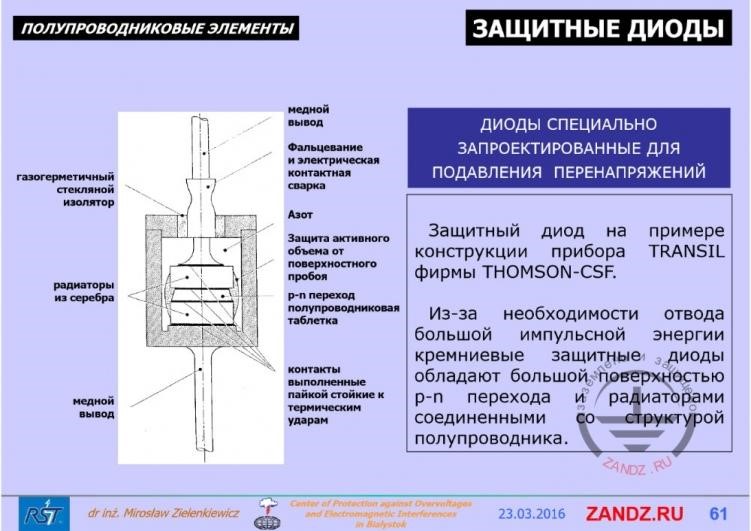
Protective diode on an example of TRANSIL device construction
Полупроводниковые элементы – semiconductor elements
Варисторы ZnO – ZnO variable resistors
Медный вывод – copper output
Газогерметичный стеклянный изолятор- gas-hermetic glass insulator
Радиаторы из серебра – silver radiators
Медный вывод – copper output
Фальцевание и электрическая контактная сварка- seaming and electric contact welding
Азот - nitrogen
Защита активного объема от поверхностного пробоя- protection of an active volume from a surface puncture
p-n переход полупроводниковая таблетка – p-n transient , semi-conductor pill
контакты выполненные пайкой стойкие к термическим ударам – contacts performed by bending, resistant to thermal stress
диоды специально запроектированные для подавления перенапряжения – diodes specially designed for suppressing overvoltages
защитный диод…. – protective diode on the example of TRANSIL device by the company THOMSON-CSF.
Due to the need to drain large pulse energy, silicon protective diodes possess a large surface of p-n transit and radiators connected with the structure of the semiconductor.
- if we look at the structure of this diode, I indicated the example of TRANSIL element of the company THOMSON - CSF. We see that this element is specially developed for draining great pulse energy. And if we look at this element well, I am using an arrow to help you see the p-n transition, which has a great surface, the great volume in relation to a semi-conductor, used diodes for other cases. Two radiators made of silver of great capacity drain large heating energies, which are liberating energy at the surge current flowing. Then we see specially made and connected copper tabs. We let it run through the frame inside which there is nitrogen. Nitrogen is characterized by good thermal characteristics. It rejects heat well, which is generated in this transition here. If we look at the material placed between these electrodes. It is a special material, which protects from a surface puncture inside through nitrogen, increases puncture voltage. In practice all these elements are created so they reject thermal energy as much as possible.
Полупроводниковые элементы – semiconductor elements
Варисторы ZnO – ZnO variable resistors
диоды специально запроектированные для подавления перенапряжения – diodes specially designed for suppressing overvoltages
- Since such an element - diode is an element which can't conduct partial lightning currents, these are small elements and the most important thing for us is that these elements are characterized by very low limit voltages. Regulating well, we can pick any voltage we want, from several volts to several hundreds of volts and connect to our circuit. We see that these elements are small in size that is why, it is clear to us that the energy can't be large.
Полупроводниковые элементы – semiconductor elements
диоды специально запроектированные для подавления перенапряжения – diodes specially designed for suppressing overvoltages
характеристика U-I - U-I characteristics
Parameters of protective diodes:
Neutral voltage – maximal voltage value of the DC current at which the diode doesn’t switch yet
Leakage current
Sparking voltage – voltage value determining the start of the avalanche multiplication (for start of multiplication higher than 8 V Ubr is defined for 1 mA)
Maximal peak current – current value flowing through the diode volume when testing it by the standard pulse
Maximal peak voltage at the current Irsm (maximal voltage value, which may appear on the clamps of the circuit protected by the diode)
Pulse unrepeated dissipation power
- The disadvantage of these elements is non symmetrical response characteristics. Due to the fact that we need to use two elements for surge protection, which makes the circuit more expensive, there is no way out here. The leakage current is weaker here than with the variable resistor, but they also characterize our element. If we look at the parameter which we need most of all. I see I haven't indicated it. The capacity is quite high.
<< Previous Page
Slides 30 to 45
Next Page >>
Slides from 61 to 74 + questions
Useful materials for designers:
- Webinars with the leading industry experts
- Everything for the calculation of grounding and lightning protection
- Useful materials: articles, recommendations, examples
Related Articles:


